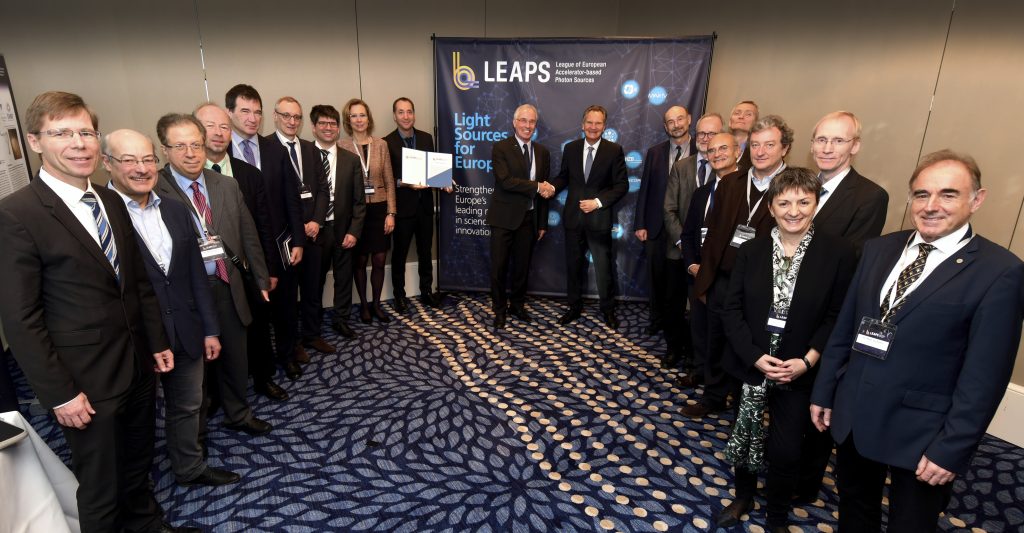LEAPS Launch Event
At the LEAPS launch event in Brussels on 13 November 2017, 16 organisations representing 19 light source facilities across Europe signed an agreement to strengthen their collaboration. The event was attended by Robert-Jan Smits, Director-General for Research and Innovation of the European Commission, and Giorgio Rossi, Chair of the European Strategy Forum on Research Infrastructures (ESFRI).

Some 150 participants from all over Europe as well as guests from the US joined discussions and gave input to the board of LEAPS how to best use the power of combined effort to ensure that European light source facilities continue to be world-leading.
Hans Chang, first Chair of ESFRI, chaired the meeting and described the intentions behind the LEAPS initiative with a quote from an African proverb: If you want to go fast, go alone. If you want to go far, go together.
Professor Helmut Dosch, Chair of LEAPS and Director of DESY, said in his opening statement: “National light source facilities have so far mostly been developed and operated independently of each other, yet they have much in common because most of their scientific objectives are very similar.” The new form of collaboration of LEAPS is supposed to ensure that European research infrastructures can be used even more effectively and that technological challenges can be tackled jointly in the future. “LEAPS will become a catalyst for impact on the global challenges, a key driver for competitiveness and a compelling force for closer integration and peace through scientific collaboration.”
Robert-Jan Smits sees the efforts of LEAPS fully aligned with the policies and programmes of the European Union: “This integration of European research infrastructures is key for the use of resources by avoiding the deprecation of efforts and for maximising the scientific, economic and societal impact.” He expressed further why he backs LEAPS: “The first reason is because you have made it clear that you want to be inclusive in your further integration efforts; to include different countries, many facilities, not only in Europe but also be eager to work across the globe… The second reason is that one of your objectives is to strengthen the interaction with industry with your objectives striving towards optimal exploitation of synchrotron and FEL user facilities for industrial research. Unlocking the innovation potential of research infrastructures and stimulating industry engagements is one of the priorities which we have identified in our recently published document on the long-term sustainability of European research infrastructures. The third reason is that you embrace open science. You make it quite clear in your position papers that you want to share data, curate data, make data interoperable, respect the FAIR principles, and work together with the European Commission on creating this European Open Science Clouds. Another reason why I like LEAPS is that you are also putting yourself with certain deliverables. You are making it clear that you want to identify key performance indicators which is an excellent way to measure and to monitor the impact of your activities”
Robert-Jan Smits ended his talk by saying: “As you also know we are gradually starting the preparation for the Framework Program 9, and here I count on LEAPS for your input. Because in the field of infrastructures, with key communities, I would like to step away from the project-by-project funding and go more to the allocation of programs to well-organised and self-organised communities which have ambitions, which have scalable scopes and are indeed able to act in a strategic partnership way with the European Commission.”
The LEAPS launch event continued with statements by the chair of ESFRI and representatives from national ministries and funding agencies as well as with panel discussions covering different topics: how the LEAPS initiative can push excellence in science, push innovation and industry in Europe, and what it can do for integration, sustainability and education.
11 young scientists presented their recent research results at European light sources in the poster session during the coffee breaks:
Caroline Bissardon, ESRF – “Improve Treatment of Osteoarthritis”
Martina Dell’Angela, Elettra – “Organic Solar Cells”
Carlos Escudero, ALBA – “Batteries, Corrosion, Reactions in Atmospheres like on Mars”
Jörg Standfuss, PSI – “Structural Dynamics, Millisecond Crystallography”
Claire Murray, Diamond – “Supramolecular Chemistry”
Dominik Oberthuer, DESY – “Drug Design / How does Photosynthesis Work”
Charlotte Sanders, ISA Aarhus – “Design of Novel Materials and Next Generation Devices”
Matthias Schwarzkopf, DESY – “Nanostructures / Better Solar Cells”
Marco Stampanoni, PSI – “Medical Imaging, Tech Transfer to Hospitals”
Alina Vlad, Soleil – “Better Catalysts for Automobiles”
Dennis Voeten, ESRF – “Palaeotontology: Did the Archaeopteryx Fly?”
